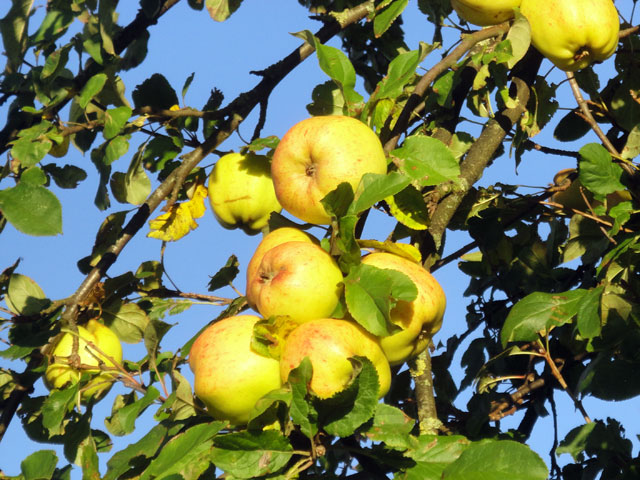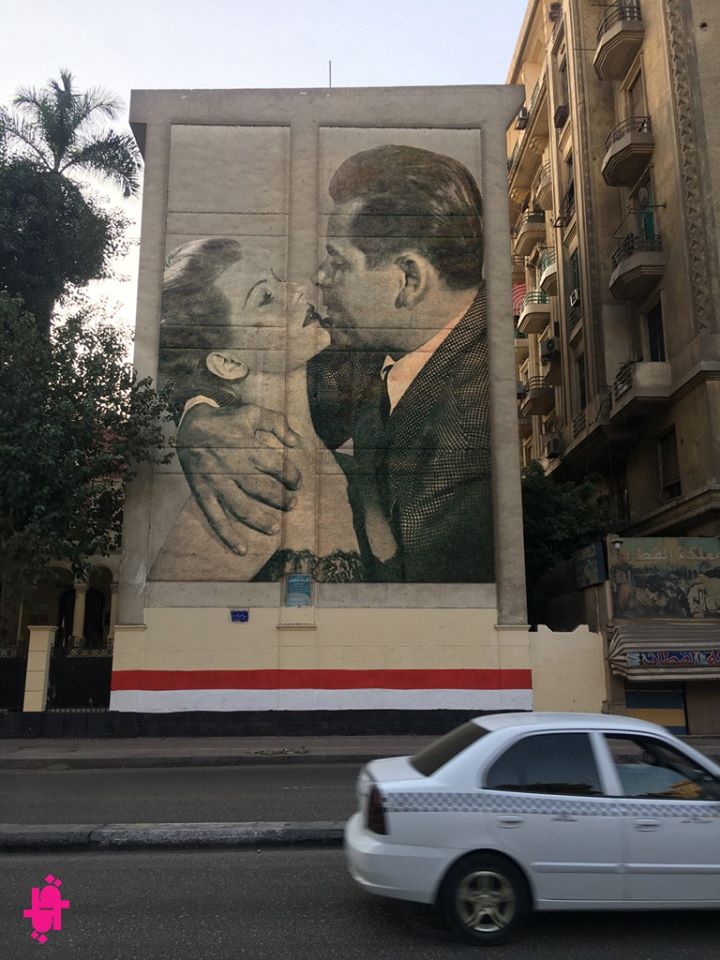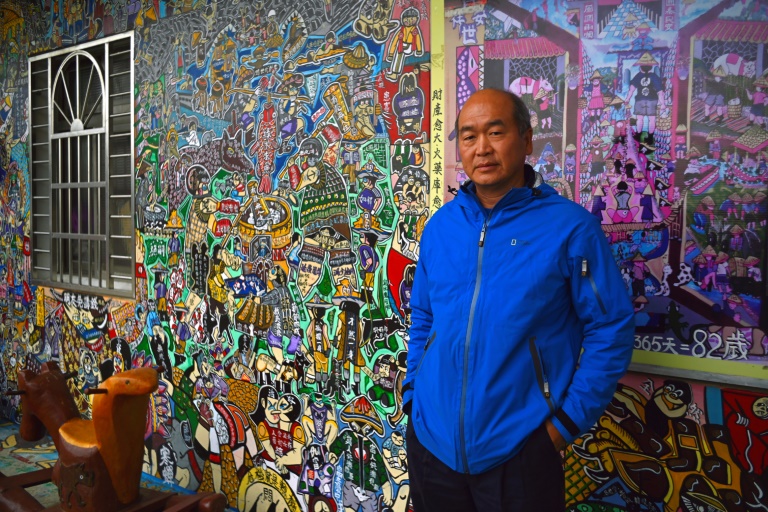
Artist Omneia Naguib wants to “occupy the sky” by moving the familiar language of the street — imprints of political posters and common graffiti motifs — onto the grandiose billboard spaces typically reserved for those with power and money.
Protesters are placing eye patches, a symbol of their injuries, on the Qasr al-Nil lion statues, and pedestrians seek shadow underneath them or shower in a fountain in one of Cairo’s roundabouts. The domineering vision of the state and private corporations of what constitutes public art has opened up since the January revolution began.
Activists, residents and artists alike are all negotiating public space and art to send out their messages, connect more closely with their communities or simply feel at home.
Here, a group of our staff writers and contributors present you with some of the narratives of these people, their successes and failures, and how they are gradually re-appropriating their city.
Informality brings on a new urban order
By Omar Nagati and Laura Cugusi
On the first anniversary of the 25 January revolution, thousands of protesters carried the Martyrs Obelisk, a massive construction to commemorate those killed in clashes with police and military forces, from Shubra all the way to Tahrir Square.
This act can be seen as a ritual of bestowing sacred meaning to “ground zero,” and replacing the Square’s representations of former political and aesthetic orders.
The January upheaval was a revolt against decades of the state’s steady de-legitimization and repression of modes of expression that have been emerging in working-class neighborhoods and “informally” reshaping popular culture and space boundaries. Public space became a site of contestation between formal yet decaying orders, and new approaches to expression and spatial organization that are still in the making. Adding anti-state stickers on state-made lampposts, covering nude sculptures with blankets and deeming them inappropriate, resting in the arms of a statue, or picking a sculpture as a landmark for street vending are all manifestations of this alternative urban order, as are the proliferation of street art and new means of artistic expression.
Public art in Egyptian cities has been often conceived from the position of state actors to propagate a nationalist message and create an “aesthetically pleasing” environment. But non-state actors, such as protesters, residents and artists, have a different vision, which even extends to the way they interact with existing monuments. Downtown streets, which are seemingly awash in a sea of chaos, are also being reconstituted spatially and aesthetically through the small but cumulative acts of peddlers and street vendors, each redefining their domain from “inside out” as the city as whole is restructured.
A short history of public art
Mostafa al-Razzaz, artist and former assistant dean of the Helwan University Faculty of Art Education, says the history of public art in Egypt falls in three main phases: the colonial movement at the turn of the 20th century; Arab nationalism and state-sponsored art through the 1950s and 1960s; and the neo-liberal shift and regional cultural influences brought about by migration to the Gulf, from the 1970s onward.
Khedive Ismail’s modernization plan included the construction of European-inspired boulevards radiating out of squares, a symbolic break with the ramshackle old center of the city. In a public statement, he proclaimed: “My country is no longer in Africa; we are now part of Europe. It is therefore natural for us to abandon our former ways and to adopt a new system adapted to our social conditions.”
Modern public art such as statues, fountains and decorative street furniture started to appear in the early 1900s, influenced by European and American cities’ beautification projects.
After the 1952 revolution, President Gamal Abdel Nasser sought to reshape the country’s post-colonial identity. Through socialist-style architecture, modern and industrial interior design, new infrastructure and landmarks that appeared in squares, road junctions and near strategic sites, the look of the city changed irreversibly.
Another shift occurred with the privatization era that started with former President Anwar Sadat. In the process, the unfolding public art reflected intersections of new forms of nationalism, capitalism and religion.
“Many Egyptian engineers migrated to the Gulf and when they returned, they imported a new aesthetic sense inspired by Saudi Arabia’s public design style, which often chose to reproduce inanimate objects in large scale, also to avoid representing the human figure,” Hafez Shawky, professor at the Helwan University Faculty of Fine Arts, explains. Representing human figures is forbidden in radical Islam.
Moreover, the economic shift over the past three decades transformed public space into a source of revenue for corporate businesses and harnessed public art as an advertising-generating tool. Whether it is a fountain with spouting dolphins or penguins, a nationalist hero, or a miniature of an ancient temple, what matters in advertisers’ monuments are the corporate logos’ scale, proportion and strategic location. The monuments’ designs remain almost irrelevant to the commercial messages they convey and their environments.
Allowing commercial agents to take over public space can also be seen as “informal,” as it lies in a tangle of bribes and contractors’ deals with governmental authorities that tend to close an eye on legal restrictions.
Hence, public art became instrumentalized to impose an urban configuration informed by neo-liberal economic policies and corruption, where appropriation of public space through the power of capital became the message — a statement of power.
A future for the people
While the process of informalizing city structures could be traced back centuries, the popular revolt ushered new manifestations of how city streets, public spaces and symbols are re-appropriated.
At the entrance of Misr University in 6th of October City, one is greeted by a large artificial rock formation reminiscent of Mount Rushmore. Of the four sculpted figures, Hosni Mubarak surmounts the hilltop; the other three — Nobel Prize laureates Sadat, writer Naguib Mahfouz and scientist Ahmed Zewail — occupy a less prominent status. In 2011, Mubarak’s nose and face were smashed and covered with sprayed insults. The act of vandalism, while not as dramatic as the toppling of Saddam Hussein’s statue in Baghdad, is still highly symbolic.
The victorious, papier-mache human fist in Tahrir and the speakers protesters attached to the Talaat Harb Square statue to amplify the chants of protesters who gathered in the square are also emblematic.
Such phenomena show people’s need to create tangible symbols that express positive values, a sense of belonging and unity — ones that can become a legacy for future generations. They show how, at a historical moment of transition, a redefinition of the role of culture as a function of a transformed and a transforming vision of the present and of the future unfold.
A Japanese deity in Fustat
By Helen Stuhr-Rommereim
After three years studying in Japan, artist Rania Fouad felt she needed to find a way to reconnect with her city. To her that meant intentionally working with an inaccessible image like Jizo, a deity of Japanese mythology.
She painted it on a tree in the Cairo neighborhood of Fustat, employing traditional Japanese methods of painting — gilding, mixing paints with dye and glue — and, over four long days, created a small, intricate image of an unfamiliar god. Fouad chose to employ such a time-consuming process because she wanted to force herself to be present in an unfamiliar neighborhood.
She knew the figure she was painting, a god that is outside both Christian and Muslim theology, would be potentially problematic for many people.
“I thought there would be a lot of misinterpretations, but this is the state that I wanted to express,” she says.
She spent her time talking to children on the street, explaining what she was doing, and experiencing little stories while standing. The time spent on the street was more important than the image.
Reconsidering communications
By Helen Stuhr-Rommereim
Artist and freelance photographer Enas Abu al-Komsan created an image she hoped would encourage acceptance and understanding between divergent populations in Egypt. She, however, worked in a didactic mode, painting two images: one of a secular young man holding the hand of a veiled woman, the other of an unveiled girl in a skirt holding hands with a young, bearded man in a galabeya. Komsan placed her images in Maadi, Zamalek, and in Tahrir Square. After one day they had all been destroyed.
“I was disappointed,” says Komsan, “I felt that people in Egypt do not understand art.”
But the destruction of her few posters shows that a handful of people in Egypt did not understand or simply disagreed with her art. The posters were large and imposing, and she placed them in only a small number of locations at a moment when presidential elections and the verdict of Mubarak’s trial were stoking tensions in the city.
The burden is on the artist to understand her audience, and find a way to actually communicate. Now, Komsan is considering various adjustments to size and image that could help her speak more clearly.
Lions look within
By Jenifer Evans
The four bronze lions guarding Qasr al-Nil Bridge, huge but easy to climb, have long been a prime location to pose for photos. Putting an eye-patch on one of them was a simple DIY gesture that turned the lions and their bridge into pro-revolutionary monuments.
Eye wounds were one of the most common injuries of the uprising and subsequent protests. The soft white patch symbolized the state’s weakness, angering those in power who could not protect public monuments, even in the most prominent of locations. Other statues — like those of Talaat Harb and Om Kalthoum — also got eye-patches, but the small bandage on Henri Alfred Jacquemart’s sad but dignified lion most poignantly symbolized the state’s destruction of the nation’s pride, its mutilation and killing of heroes.
Compared to 6th of October or Gamaa Bridges, with their cafes and vendors, pre-2011 Qasr al-Nil was one of the more strait-laced of Cairo’s bridges, a short narrow touristy one near a number of official buildings. It was just used for getting from A to B, or for romantic strolls. But, it has been reclaimed as a more flexible and free space since the uprising, in which it played an important role. The vendors that sold refreshments and flags to protesters never left. Motorbikes mount the pavements, and policemen rush up, slightly too late to stop boys diving off the bridge.
If you were president
By Helen Stuhr-Rommereim
From the beginning of developing his project, artist Amado Alfadni knew he needed to find an unimposing visual language, because he hoped that people would respond and interact directly with the poster he was creating. He went through a long series of designs for his ultimately very simple poster: a mostly blank sheet of paper that poses the question “If you were president, what would you do?”
After looking at a few designs made by friends, Alfadni says, “I wondered, how would people in my neighborhood [Abbasseya] react to that? Or how would it look in an ally in old Cairo?”
In the end, he chose something with minimal design elements, with text in hand-written calligraphy, that would blend in with the kinds of handmade signs and posters found in neighborhoods like Abbasseya.
Alfadni was looking for a direct conduit between himself and a wide swath of the public, and he was largely successful because as he designed and distributed his posters, he kept in mind the nature of the neighborhoods he was working in. He tried to be a part of their distinct visual environments.
Walls are no barriers
By Jenifer Evans
When the construction of eight walls across various streets in downtown Cairo began in November, ending speculation about army trucks mysteriously carrying around huge cement blocks, there was a surprising lack of outrage.
Even though this desperate attempt to control public space compounded traffic problems, forced businesses to close and required people to take massive detours, the people seemed to grudgingly accept the inconvenience. After all, they were much more solid than the short-lived wall built outside the Israeli Embassy earlier that year.
But if people are used to bizarre decisions from above, they are also used to turning a humiliation into a creative opportunity. They quickly drew and wrote over the walls. Some climbed up and stood atop them. Others formed a “Drawing Through Walls” project to reopen the streets by visually removing the walls, painting trompe l’oeil scenes on them. The Ultras Ahlawy painted a revolutionary mural on a previously insignificant corner that had suddenly filled with traffic, and therefore audience members, due to the detours. People wrote articles and drew cartoons that used the walls to symbolize the military’s failure.
A Gizean waterfall
By Mai Elwakil
On a sunny, humid July day, the octagon-shaped fountain in the small Kit Kat roundabout was flowing with water as usual. The traffic policemen at the opposite checkpoint were on duty and pedestrians gathered by the nearby Nile-view Cinderella cafeteria.
Everything seemed to be proceeding as usual. President Mohamed Morsy’s election campaign posters still lined the fountain’s beige porcelain exterior, though the edges were scraped off by the intense sun rays. Suddenly, a group of children showed up for a swim.
Some dived into the fountain in their swim trunks. Others, wearing their shorts, simply splashed one another with the fresh water, which offered a perfect refuge from the scorching heat. Many residents of the working-class Giza neighborhood of Imbaba could not afford to take a trip to the beach this summer.
A few passers-by objected to the spontaneous act, reminiscent of the famous fountain scene from the 2002 adaptation of “Scent of a Woman,” starring comedian Adel Imam. But the children were not bothered, and many families were happy that their children could enjoy the cool water in the fountain, once built by the state for purely decorative purposes.
This piece was originally published in Egypt Independent's weekly print edition.










